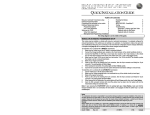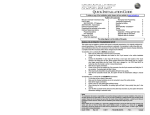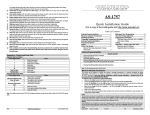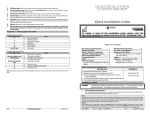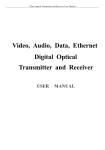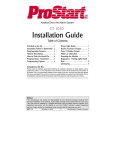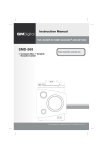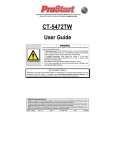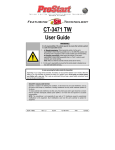Download ProStart CT-3271 User guide
Transcript
Parking brake shutdown circuit (manual transmissions only). With the vehicle running under remote start, disengage the parking brake. The engine should shut down immediately. If the engine continues to run, check the parking brake switch connection. OEM alarm control. Make sure the module is able to arm and disarm the OEM alarm (if applicable). Door locks and trunk testing. Make sure each of these options respond to the transmitter (if installed). Door pin shutdown circuit (manual transmissions only). Make sure the system exits ready mode when each door is opened. (Test each door.) Starter kill option. Sit inside the vehicle with all doors closed. Arm the vehicle, then try to start the engine with the key. The engine should not start. If the engine starts, rewire the starter kill to reach proper operation. Valet mode. Make sure the remote car starter is able to properly enter and exit valet mode. When setting the remote car starter into valet mode, pressing the BUTTON will lock the doors without activating the starter kill. (Refer to the user guide for further information on valet mode.) Idle mode. Make sure the vehicle properly enters and exits idle mode. Door. Make sure that when the system is armed, opening any door or opening the trunk will trigger the alarm (if installed). Most comebacks are the result of misunderstandings about how a product works or performs. Take the time to properly explain all functions and features to the customers before they leave the premises. Doing this will save time and money. DIAGNOSTICS – PARKING LIGHT FLASH TABLE Diagnostic table for start failure. Parking lights flashes 1 (Manual transmission only) 1 slow Î 2 quick 1 slow Î 2 quick Î 2 quick 3 (Automatic transmission only) 4 5 (Manual transmission only) 6 10 Diagnostic table for shutdown. Parking lights flashes 1 2 3 4 10 Flash for 30 sec. M A N U A L / A U T O M A T I C T R A N S M I S S I O N 2 - B U T T O N R E M O T E S T A R T E R W I T H V I R T U A L T A C H S Y S T E M ( A S P R G - 1 0 0 0 C O M P A T I B L E ) QUICK INSTALLATION GUIDE To obtain a copy of the full installation guide, please visit our website at www.prostart.org TableofContents Manual or Automatic Transmission setup .......... 1 Transponder Programming ................................. 5 Push To Start ...................................................... 2 Resetting the Module .......................................... 5 Hybrid Option ...................................................... 2 Bypass................................................................. 5 Entering Programming Mode .............................. 2 SmartStart™ ....................................................... 5 Programming the transmitter to the module ....... 3 Testing................................................................. 5 Entering Programming Options .......................... 3 Diagnostics – Parking Light Flash Table ............ 6 Programming Options 3 Diagnostic table for start failure. 6 Setting up the TACH ........................................... 4 Diagnostic table for shutdown. 6 Virtual Tach adjustment 4 Multi-speed Tach Programming 4 The wiring diagram is at the middle of this guide. The functions of the transmitter are as follows: Remote Function OPTION 1 BUTTON: STOP BUTTON: START/STOP BUTTON & BUTTONS (together): TRUNK Cause x Ready mode is not activated. x x x x x x The system is set to valet mode. The system is in Home valet The parking brake is active. Yellow loop is connected. Brake wire is active. Tach signal is not learned. x x A tach signal is detected before Ignition. Hood wire is active. x x x x x x x Cause Runtime has expired. Shutdown by remote. Ready mode is activated. Failed start (VTS or tach failure, depending on selected). Brake shutdown. Hood shutdown. Panic mode. Remote Function OPTION 2 BUTTON: LOCK/UNLOCK BUTTON: START/STOP BUTTON & BUTTONS (together): TRUNK MANUAL OR AUTOMATIC TRANSMISSION SETUP This module may be installed on vehicles with manual or automatic transmissions. It is originally configured for manual transmissions. If the vehicle you are working on is automatic, it is mandatory to make a few quick and easy modifications before the unit is connected. In the event that the configuration requires changes afterwards, a complete reset will be necessary before those changes become effective. Note: The installer can also use the PRG-1000 to diagnose shutdown and remote start failures. Refer to the PRG-1000 manual guide. To install this unit in a vehicle with a MANUAL transmission: 1. Make sure the Yellow loop on the PC board is connected. 2. Connect the Orange handbrake wire located on the 12-pin harness to the vehicle handbrake switch. 3. Connect the Blue/White (+) door input OR the Grey (-) door input wire located on the 12-pin harness to the vehicle door pin wire, which monitors all the doors of the vehicle (only use 1 of the 2 door trigger inputs). 4. Make sure the Purple TACH wire is plugged in – the TACH wire MUST be hooked up when the module is set for a manual transmission. 5. Make all your regular connections. 6. Power up the unit by first inserting the 5-pin connector, then the 6-pin connector and finally the 12-pin connector. The parking lights will flash 4 times. 7. When learning the transmitter, the parking lights will flash 5 times quickly. 8. Upon the first successful remote start, the system will lock the transmission settings to manual mode. To install this unit in a vehicle with an AUTOMATIC transmission: 1. Cut the loop on the pc board (Yellow wire). 2. Make sure the Orange handbrake wire is not connected to any of the vehicle circuits. 3. Make all the regular connections. 4. Power up the unit by first inserting the 5-pin connector, then the 6-pin connector and finally the 12-pin connector. The parking lights will flash 4 times. 5. When learning the first transmitter, the parking lights will flash 5 times quickly then give 2 slow flashes. Notice The manufacturer will accept no responsibility for any electrical damage resulting from improper installation of the product, be that either damage to the vehicle itself or to the unit. This unit must be installed by a certified technician using all safety devices supplied. Please note that this guide has been written for properly trained Autostart technicians: a certain level of skills and knowledge is therefore assumed. Please review the installation guide carefully before beginning any work. Warning Before installing the unit, if installing on a vehicle with a manual transmission, test that the OEM Door Switch contacts of the vehicle work well, and that the Parking Brake system operates properly. If installing on a vehicle with an automatic transmission, test that the vehicle does not start when the gearshift lever is in the “Drive” position. If it starts in gear, reset the remote starter to manual transmission. P.6 Quick Installation Guide Doc#: 110530 Rev.: 1.0 © 2011 - CT-3271 - - FcN - Canada 6. Upon the first successful remote start once the yellow loop has been cut, the system will lock the transmission settings to automatic mode. Note: If upon pressing the button, the parking lights give 3 slow flashes, make sure that the Orange handbrake wire is not connected, the hand brake is not engaged and that the yellow loop is cut and isolated/taped. TRANSPONDER PROGRAMMING This procedure is detailed in the full installation guide. To obtain a copy of the installation guide, please visit our website at www.prostart.org. RESETTING THE MODULE PUSH TO START Disabled by default, PTS mode is a special feature that is intended to facilitate the remote starter installation on most Push To Start vehicles. With PTS mode enabled, the remote starter will offer the installer a negative start output (to pulse the vehicle’s PTS switch), as well as a (+) brake switch output (no external relay necessary). With PTS enabled, the White/Green wire on the 12 pin harness becomes your negative (-) PTS switch output. It will give a one second output intended to pulse the PTS switch. Also, the Purple crank output becomes your brake switch output (this will turn the brake circuit ON for crank). WARNING! By resetting the module, all programmed values are erased i.e.: tach, transmitter as well as programming options. The programming options are returned to their default values. 1. In programming Mode (page 2). 2. Once having reached the programming mode, quickly press and release the brake pedal until the parking lights flash 8 times. BYPASS HYBRID OPTION Remote starters of this series have the ability to work in two way mode (D2D) with Xpresskit bypass modules. They also offer one way communication with Xpresskit, ADS and Fortin brand bypass modules. Note: For Hardware 5.0 and higher there can only be one bypass connected to the unit. Warning: For automatic transmissions only. This option is disabled by default. It can be enabled in Mode 2 of the programming options. HYBRID mode is a special feature that is intended to facilitate the remote starter installation on most Hybrid vehicles. With HYBRID mode enabled, the remote starter will give a four second crank output on its crank wire (It will not rely on VTS to stop the crank cycle). The only way to shorten the four second crank output is to program a tach signal to the remote starter. If a tach signal is programmed, the remote starter will act like normal (the HYBRID feature should be used when a tach reference is not available from the vehicle or the bypass being used at the time of installation). ENTERING PROGRAMMING MODE SMARTSTART™ When teamed up with a SmartStart™ module (ASMC100), remote start features can be accessed using a smartphone. These features include lock/unlock, engine start/stop, trunk release, panic and alarm notifications. For alarm notifications, the Xpresskit™ bypass option (D2D) must be enabled. To use these features, connect the SmartStart™ module to the SmartStart™ port located at the back of the remote start module (see the wiring diagram). The SmartStart™ feature must be enabled using the programming options list found in this guide. TESTING These are the programming buttons: Before putting the vehicle back together, it is recommended to check that the system operates properly. The following testing procedures should be used to verify proper installation and operation of the system. Before testing, make sure that all connections are soldered and that the unit is plugged in. Make sure the system properly enters and exits ready mode: Ready mode is a sequence of steps that must be followed in order to allow manual transmission vehicles to be remote started. To get into ready mode: The Hood Pin The Programming Button (a.k.a. the P.B.) If Ready Mode is enabled by remote If Ready Mode is enabled by handbrake 1. Ensure that all the doors, hood and trunk are closed. Make sure that the gear selector is in the neutral position. 2. With the engine running, apply the parking brake once and release the brake pedal. 3. Within 20 sec. of engaging the parking brake press and hold or on the transmitter. The parking lights will flash 3 times quickly and remain lit. Remove the key: the engine will continue running. The P.B. is located on the side of the module. This push button mimics the hood-pin switch in order to avoid having to get out of the vehicle and pressing the hood-pin switch. The P.B. will work only when the hood pin is installed and the hood is up. Complete step by step programming 1) Entering Programming Mode 2) Programming the transmitter (the remote) to the module 3) Entering Programming Options 4) Programming the options 5) Adjusting the Horn 6) Setting up the TACH: VTS Or Multi-speed Tach Entering programming mode using the Hood Pin x Press and hold the hood pin down for 4 seconds. x Release the hood pin. The parking lights will turn ON. x While the parking lights are ON, press the hood pin once more and release immediately. The parking lights will turn ON and stay ON for 20 seconds leaving you time to select one of the sub-menus. Note 1: To exit programming mode, close the hood. Note 2: For vehicles that require the ignition to be turned ON to activate the brake circuit, follow these steps: x After flashing the hood, turn the ignition ON and wait for the parking lights to come ON. Then, press the brake pedal to access the sub-menus. P.2 Quick Installation Guide 4. 2. With the engine running, apply the parking brake twice within 10 sec. Make sure to release the brake pedal. The parking lights will flash 3 times quickly and remain lit. Skip to step 4. 5. Exit the vehicle and close all doors, hood and trunk. 6. For approx. 1 second, press either the 7. The parking lights will flash twice to confirm ready mode activation. or the BUTTON. The system will exit ready mode if a door, the hood or the trunk is opened, if the brake pedal is pressed, if the parking brake is disengaged or if the ignition key is turned to the IGNITION ON (RUN) position. Remote-start the engine and listen for starter drag. If the starter cranks for too long, carry out another tach programming procedure. Hood switch shutdown. With the vehicle running remotely, open the hood; the vehicle should shut down. If it does not shut down, check the hood pin-switch and its connector. Brake shutdown circuit. With the vehicle running remotely, press and release the brake pedal. The engine should shut down immediately. If it continues to run, check the brake switch connection. Quick installation Guide P.5 OPTION 2* Run time = 15 minutes in gas mode / 20 minutes diesel mode OPTION 3 Run time = 25 minutes in gas mode / 30 minutes diesel mode FUNCTION 2 – Idle Mode & Turbo Mode (auto) / Turbo Mode (manual) OPTION 1 Idle mode & turbo mode DISABLED (AUTO) / turbo mode DISABLED (MANUAL) OPTION 2* Idle mode & turbo mode ENABLED (AUTO) / turbo mode DISABLED (MANUAL) OPTION 3 Idle mode & turbo mode ENABLED (AUTO) / turbo mode ENABLED (MANUAL) FUNCTION 3 – Engine type and Cold Weather Mode OPTION 1 Diesel mode with 20-minute run time in cold weather mode (30-sec. wait to start delay) OPTION 2* Gas mode with 3-minute run time in cold weather mode OPTION 3 Diesel mode with 8-minute run time in cold weather mode (18-sec. wait to start delay) FUNCTION 4 – Constant Lock/Unlock or Horn output (when Mode2, Function6, Option1 is programmed) OPTION 1 N/A OPTION 2* Lock/Unlock constant output when the BUTTON is pressed >3 sec. OPTION 3 Horn confirmation upon the 1st press of the BUTTON. FUNCTION 5 – SmartStart™ OPTION 1 SmartStart™ ENABLED OPTION 2* SmartStart™ DISABLED FUNCTION 6 – Remote functions OPTION 1 Button = Lock/Unlock, Button = Start/Stop, & Buttons = Trunk OPTION 2* Button = Stop, Button = Start, & Buttons = Trunk FUNCTION 7 – Ready Mode Option / Hybrid option OPTION 1 Enabled by handbrake OPTION 2* Enabled by remote OPTION 3 Hybrid option ENABLED PROGRAMMING THE TRANSMITTER TO THE MODULE 1. 2. 3. 4. In programming mode (page 2) - the parking lights will stay on for up to 20 seconds. Before the lights go out, turn the ignition key to the Ignition On (Run) position and immediately to the OFF position. Press and hold the BUTTON and keep it down until the parking lights flash 5 times quickly. The transmitter has been stored in memory. Close the hood to end the procedure. Each unit can store 4 remotes in its memory. 5. You have 20 more seconds to select one of the sub-menus if needed. ENTERING PROGRAMMING OPTIONS 1. In programming mode (page 2) the parking lights will stay on for up to 20 seconds. 2. Before the lights go out, press and hold the brake pedal and then press one of the following buttons. x x BUTTON to access mode 1; BUTTON to access mode 2; 3. The parking lights will flash once or twice to confirm entry into a mode. 4. Release the brake pedal. Once the desired mode has been selected, the unit will fall (by default) into function #1 of that mode; you can now select the option you want in function 1. Once this option has been chosen, the unit will move on to function 2 of the mode selected, and so on. x x x BUTTON to access option 1; BUTTON to access option 2; & BUTTONS to access option 3 5. You have 20 more seconds to select one of the sub-menus if needed. SETTING UP THE TACH PROGRAMMING OPTIONS VIRTUAL TACH ADJUSTMENT Warning: For automatic transmissions only. Virtual Tach System combines the latest microcontroller technology and a complex algorithm that took years to develop. VTS is able to effectively monitor the engine starting sequence and release the starter at the right time without physically connecting the tach wire to the remote starter. The VTS constantly monitors the data and readjusts itself automatically in order to maximize its capability to start the engine properly in any weather or deteriorating battery condition. OPTIONAL TIME DELAY ADJUSTMENT IN VIRTUAL TACH SYSTEM Follow these steps to program crank time adjustment, if needed: 1. In programming mode (page 2). 2. Before the lights go out, press and hold the brake pedal and press the BUTTON and BUTTONS simultaneously the parking lights will flash 4 times. Do not release the brake pedal. 3. Press the BUTTON if you wish to increase the time delay or the BUTTON if you want to decrease it. The time delay will be increased or decreased by 50 ms and the parking lights will flash once every time the BUTTON or the BUTTON is pressed. 4. Press the and BUTTONS to save the settings you have entered. 5. Release the brake pedal – the time delay programming is now complete. MULTI-SPEED TACH PROGRAMMING 1. In programming mode (page 2). 2. Before the lights go out, press and hold the brake pedal and press the and BUTTONS simultaneously the parking lights will flash 4 times. At that point, release the brake pedal. 3. Start up the engine and allow the vehicle to reach regular engine idle speed. 4. Once the engine is running at normal idle speed, press the brake pedal and keep it down until you hear the parking lights output click 5 times. 5. Release the brake pedal the tach programming is now complete. Caution! – Tach jumper settings: Some new vehicles have a higher TACH voltage threshold, which would fall out of the normal TACH trigger circuit of the remote car starter. Changing the jumper to TACH Threshold HIGH will allow the module to properly detect the TACH signal. BUT, if you are having trouble with the TACH, please call our tech support team. Problems requiring changing the TACH jumper settings are very rare. P.4 Quick Installation Guide * INDICATES DEFAULT SETTING MODE 1 FUNCTION 1 – Ignition-controlled door locks OPTION 1* Ignition lock DISABLED OPTION 2 Ignition lock ENABLED FUNCTION 2 – Secure Lock OPTION 1* Secure lock DISABLED OPTION 2 Standard secure lock ENABLED FUNCTION 3 – Passive / Active arming of the Starter Kill OPTION 1* Starter Kill Passive arming (60 sec.). Will arm 60 sec. after ignition OFF. OPTION 2 Starter Kill Active arming (only arm after LOCK is pressed) OPTION 3 Starter Kill Passive arming (60 sec.). Note: When SK is armed, pressing will produce an UNLOCK output when MODE 2, FUNCTION 6, OPTION 1 is enabled. FUNCTION 4 – Door lock / unlock pulse timing OPTION 1* 7/10-sec. lock / unlock pulses OPTION 2 4-sec. lock / unlock pulses OPTION 3 7/10-sec. lock pulse and two ¼ -sec. unlock pulses FUNCTION 5 – LED flashing OPTION 1* Enabled (will only flash when ignition is OFF) OPTION 2 Disabled OPTION 3 Enabled (will only flash when Starter kill engages (depends on Mode 1, Function 3 programming) FUNCTION 6 – Bypass OPTION 1* Xpresskit OPTION 2 ADS OPTION 3 Fortin FUNCTION 7 – Bypass Type / PTS mode OPTION 1* Two-Way communication / Push to Start DISABLED (For Xpresskit bypass only) OPTION 2 One-Way communication / Push to Start DISABLED OPTION 3 Two-Way communication / Push to Start ENABLED (For Xpresskit bypass only) OPTION 4 One-Way communication / Push to Start ENABLED * INDICATES DEFAULT SETTING MODE 2 FUNCTION 1 – Engine Run Time OPTION 1 Run time = 3 minutes in gas mode / 8 minutes diesel mode Quick installation Guide P.3 WIRING SCHEMATIC REAR VIEW OF MODULE For Automatic transmission: Cut the yellow loop before plugging the module. Jumpers for 5th relay (2nd starter, 2nd Ignition, 2nd Accessries) INV 200 (Door lock pulse inverter) Optional programming port / SmartStart Yellow Loop Xpresskit bypass ADS & Fortin bypass INV 200 Accessories 2 Jumper (Door lock pulse Ignition 2 Jumper Inverter) Starter 2 Jumper Xpresskit bypass Optional programming port / SmartStart SIDE VIEW OF MODULE Programming Assistance Button (P.A.B.) ADS & Fortin bypass Yellow Loop 3. YELLOW/WHITE .................. (-) Parking lights output 2. BLUE/WHITE.........................(-) Horn output only 1. GRAY/LIGHT BLUE...............(-) N/A 1. (-) N/A 2. (-) AUX 1 Output 3. (-) Parking lights output Optional Starter Kill Relay N/A 87 TACH: HIGH TACH Threshold: NORMAL STARTER WIRE 87A (Solenoid Side) IGNITION (+) 85 STARTER WIRE 30 86 YELLOW ........... IGNITION 30 A Fuse Start Kill Output (-) RED ..............12V (Battery) ORANGE ...ACCESSORIES (Heater Blower Motor) PURPLE............. STARTER GREEN ............ 5th RELAY 30 A Fuse RED ............+12V (Battery) 15 A Fuse 1- BLACK ........................ GROUND (-) 2- PURPLE........................... TACH (AC) 3- GREY ................. HOOD SWITCH (-) 4- ORANGE ........ BRAKE SWITCH (+) 5- YELLOW ....... PARKING LIGHTS (+) 12- YELLOW .......................... 11- GREY ............................... 10- WHITE .............................. 9- PURPLE ............................ 8- ORANGE ........................... 7- WHITE/ORANGE ............... 6- BLUE/WHITE ..................... 5- WHITE/GREEN .................. 4- WHITE/BROWN ................. 3- GREEN .............................. 2- BROWN ............................. 1- BLUE ................................. (+) Glow plug input (-) NEG. Door input (-) GROUND when running output (-) EXT. TRIGGER input (-) Parking Brakes input (-) Starter kill output (+) POS. Door input (-) DISARM output / PTS output (-) REARM output (-) UNLOCK output (-) LOCK output (-) TRUNK output V2.02 FcN - May 30, 2011





